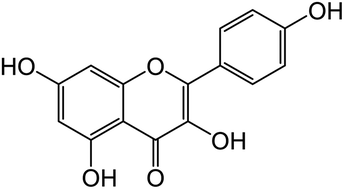Kaempferol attenuates the glutamate-induced oxidative stress in mouse-derived hippocampal neuronal HT22 cells
Abstract
It is thought that the neuronal cell loss caused by oxidative stress is the primary mechanism underlying the pathogenesis of several neurodegenerative disorders. Glutamate is an endogenous neurotransmitter, but at high concentrations it can act as a neurotoxicant by increasing the intracellular levels of reactive oxygen species (ROS). Therefore, the development of factors that can attenuate glutamate-induced oxidative stress in neuronal cells is a good strategy by which new drugs could be discovered that may treat or prevent neurodegenerative diseases. Here, the neuroprotective effects of kaempferol (KF) isolated from the stems of butterbur (Petasites japonicus) were examined in glutamate-treated hippocampal neuronal cells (HT22). The administration of KF (25 μM) resulted in a significant increase in cell viability (105.18 ± 7.48%) compared with the control (100.00 ± 3.05%), while glutamate (5 mM) reduced cell viability by 39.94 ± 1.61%. The glutamate-induced calcium (Ca2+) influx (1.93 ± 0.08-fold) was significantly reduced by 0.89 ± 0.02-fold following the administration of 25 μM KF. Additionally, when HT22 cells were stressed with excessive glutamate, there was a 3.70 ± 0.01-fold increase in intracellular ROS generation, even though this was effectively attenuated by KF (25 μM, 0.72 ± 0.01-fold). The protective effects of KF in HT22 cells were later confirmed using a lactate dehydrogenase (LDH) assay and a FITC-annexin V/propidium iodide double staining procedure. These findings also revealed that the neuroprotective effects of KF are a result of the regulation of the expression levels of proteins, such as Bcl-2, Bid, apoptosis-inducing factor (AIF), and mitogen-activated protein kinase (MAPK). This is the first report to investigate the neuroprotective influence of KF in glutamate-treated HT22 cells. These data demonstrate that KF may be a useful candidate for pharmacological therapies that can prevent and treat neurodegenerative diseases such as Alzheimer's disease (AD).


 Please wait while we load your content...
Please wait while we load your content...